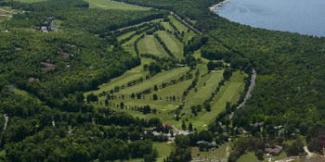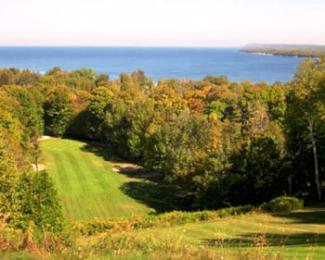Featured Golf News
Wisconsin's Door County is a Golf Destination, Too
Bucolic Door County, Wis., which encompasses the arm of land extending northeast that separates Lake Michigan from Green Bay, is known for its lakeside towns, cherries and as a haven for tourists from nearby states. The place is a step back in time; the pace of life is a little less hectic, prompting locals and tourists to refer to the area as the "Cape Cod of the Midwest."

Aerial View of Alpine Golf Club
Golf belongs on the to-do list for the region as well, as 11 courses in various configurations, states of condition and challenge welcome players along the peninsula. Many of the tracks feature routings along the huge lake or bay, with extensive views of the water and nearby islands.
Other tracks sport signature drop-off holes, places where a golfer stands on the tee and has really no idea what club to hit or how to even keep the ball on the microscopic greens below.
Some of the courses date back almost 100 years, and most take advantage of the area's limestone outcroppings of the Niagara Escarpment, which are visible on both shores of the peninsula but are larger and more prominent on the Green Bay side. Progressions of dunes have created much of the peninsula's shoreline, especially on the eastern flank.
The middle of the peninsula is mostly flat or rolling, cultivated land. Soils overlaying the dolomite bedrock are very thin in the northern half of the county as 39 percent of the region has less than 3 feet of soil atop the bedrock.
During a recent trip to the county, I played five of the area's facilities: here we'll concentrate on the oldest three - Peninsula State Park Golf Course in Fish Creek, Alpine Golf Course and Resort in Egg Harbor, and Idlewild Golf Club in Sturgeon Bay. All offer unique routings and are close to beaches, shops and restaurants, offering welcome reprieves from a day on the water.

The Downhill 8th at Peninsula State Park GC
Pack a Lunch - & Maybe Dinner - for the Round at Peninsula State Park GC
What is now Peninsula State Park Golf Course is considered one of the most scenic in Wisconsin. Designed by Larry Packard, it was proposed as two nine-hole layouts but actually opened as a six-hole course in 1917, grew to nine holes in 1923, and finally settled in as an 18-hole venue in 1931. For the first 10 years the course "featured" sand-and-oil greens; today Peninsula State Park Golf Course is lush and green and a real test of golf, one that, at times, also tries your patience.
The course, which offers marvelous views of Eagle Harbor and the village of Ephraim, is set among forests of white cedar, oak, beech and maple. The most talked-about hole is the steeply downhill, 69-yard par-3 eighth, which drops 70 feet from the tee to its postage-stamp green. Sandwiched between the ridge where the tee sits and the park's entrance road beyond the green, many golfers overshoot or undershoot this target in an attempt to adjust for the elevation change.
The back nine sports many holes with more rises and falls along a ridge, including the dogleg-left, 353-yard 10th (which moves uphill to a protected putting surface) and the drop-off, 186-yard par-3 17th, whose green is turtle-backed and falls away on all sides. The round ends at the tough, 440-yard par-4 18th, which bears out-of-bounds and a road to the right; a bunker on the left side of the green helps save errant shots from going into woods.
Of historical note, along the ninth fairway at Peninsula State Park Golf Course is a 40-foot-tall memorial pole dedicated to the Potawatomi Nation. Members of the tribe occupied the land in Door County in the 1800s. Near the pole is a large stone marker dedicated to Chief Kahquados, the last chief of the Potawatomi Nation. The bear perched atop the pole is depicted in the golf course's logo and serves as a reminder of both the park's and Door County's history.
Because the course is set in a state park - the only such facility in the Badger State - and play is plentiful, expect to spend at least five hours playing Peninsula State Park Golf Course. With a little patience and some skill, you can have a great time here.
For more information, visit www.peninsulagolf.org.
Four Times the Fun at Alpine
Built in 1925, the golf course at Alpine Resort along the waters of Green Bay in Egg Harbor is the county's iconic resort layout. With its first two nine-hole layouts designed by Fritz Schaller (and the newer 18 holes fashioned by resort owner Bill Bertschinger), the tracks are varied and often a bit forced, especially the aptly named Black and Blue nines.
Additions in 1948, 1976 and as recently as 2004 have resulted in a 36-hole layout that ranges from flat, open fairways to substantial ups and downs and scenic vistas.
The Blue and Black courses, the newer of the nine-hole layouts, are more popular than its sister courses, Red and White. A natural bluff runs through Blue and Black and the layout is a combination of holes below, in the shadows of and on top of the bluff. Some have narrow, tree-lined fairways while others feature more open, generous landing areas.

The Daunting 9th on Alpine's Blue Nine
The 275-yard, par-4 ninth at Blue plays from atop a ridge to a green surrounded by trees and is considered among the most scenic holes in Wisconsin. A 100-foot drop from tee to green makes it play closer to 220 yards. Wayward shots will end up in the trees on either side of the narrow fairway. The ninth at Black is similar; the 98-yard posted distance plays more like 60 after the drop in elevation is factored in. Plan to take a cart as getting up and down the bluffs on foot is pretty grueling.
The Red and White nines, which opened in 1926 and 1948, respectively, are the older of the four courses and are generally paired to form one of the two 18-hole layouts.
Red and White are relatively flat, with few elevation changes. Most holes have two sets of tees except on some of the shorter holes, where everyone tees off from the same markers. These courses are very walkable, and most of the holes are straight or have only a slight bend.
The seventh on Red is an interesting exception. From the tee this 356-yard, par-4 appears to be a double-dogleg, starting out straight, then veering left before turning to the right again. The key to this hole is a tee shot over the pine trees on the left side of the fairway. The White nine's best tests are its par-3s, the 195-yard fourth and the 224-yard seventh. Both are stern long-iron tests to small, raised putting surfaces.
Since 1921, Alpine Resort's spacious grounds, inviting waterfront and golf course and relaxing atmosphere - along with the staff's warm hospitality - ensure a peaceful respite you won't soon forget. The clubhouse has some great old photographs on its walls, including a picture of comedian Bob Hope who played at Alpine in the early '70s.
For more information, visit www.alpineresort.com.

Idlewild Golf Club
Marshes & More at Idlewild
Set in the Door County seat of Sturgeon Bay, Idlewild Golf Course opened in 1976 and is the flattest of the three courses featured here. The views are long and wonderful, whether you're peering down the fairways or over the surrounding treetops toward the escarpment rising in nearby Potawatomi State Park. The golf course is beautifully manicured and maintained, and the greens and bunkers are exceptional.
Set in a marshy area between the ridges and against the bay, the course's natural flora and fauna define its fairways, which venture left and right along tree-lined routes.
At Idlewild, the challenge begins at the first hole. A good drive left of the fairČway bunČker leaves a short- or mid-iron approach to a raised green guarded by a large ash tree and sand trap. Shots hit over the green leave an extremely difficult chip back.

No. 18 at Idlewild GC
The 424-yard par-4 fifth is the signature offering at Idlewild, requiring a lengthy tee shot between the lake on the right and lateral hazard left. The approach must carry Lost Creek and avoid a tall ash tree guarding a fairly flat, elevated green tucked into the woods, with a sand trap left and mounds at the rear.
Two par-4s, the 438-yard 17th and the 407-yard finishing hole, allow players to end their rounds at Idlewild with a bang.
The left-turning 17th will chalČlenge the longČest and most acČcurČate golfers as Lost Creek stretches down the left edge before cutting back through the fairway. The drive must stay right of the creek, miss a fairway bunker and be long enough to clear the corner for a unfettered view of the green. The approach, with a fairway wood or long-iron, must split a pair of greenside bunkers to settle safely onto this softly sloping target. At No. 18, the green is surrounded by water. Place the tee shot in the left side of the fairway for a glimpse of the putting surface.
Playing at 6,876 yards and to a par of 72, Idlewild Golf Course carries a rating of 72.3 and a slope of 129.
For more information, visit www.idlewildgolfclub.com.
Steve Habel is one of Cybergolf's national correspondents, contributing news stories, features, equipment and book reviews and personality profiles from his base in Central Texas. He is also the managing editor for Texas CEO Magazine and works as a contributing editor for Horns Illustrated magazine, a publication focusing on University of Texas sports. He also writes a blog (www.shotoverthegreen.blogspot.com), which features news on golf and the Longhorns, and another (www.checkinginandplayingthrough.blogspot.com) on his many travels, which took him across the nation and to 105 different golf course in 2009. Habel is a member of the Golf Writers Association of America and the Texas Golf Writers Association.
Story Options
 |
Print this Story |
